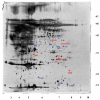Proteomics analysis of serum protein profiling in pancreatic cancer patients by DIGE: up-regulation of mannose-binding lectin 2 and myosin light chain kinase 2
- PMID: 20587030
- PMCID: PMC2906412
- DOI: 10.1186/1471-230X-10-68
Proteomics analysis of serum protein profiling in pancreatic cancer patients by DIGE: up-regulation of mannose-binding lectin 2 and myosin light chain kinase 2
Abstract
Background: Pancreatic cancer has significant morbidity and mortality worldwide. Good prognosis relies on an early diagnosis. The purpose of this study was to develop techniques for identifying cancer biomarkers in the serum of patients with pancreatic cancer.
Methods: Serum samples from five individuals with pancreatic cancer and five individuals without cancer were compared. Highly abundant serum proteins were depleted by immuno-affinity column. Differential protein analysis was performed using 2-dimensional differential in-gel electrophoresis (2D-DIGE).
Results: Among these protein spots, we found that 16 protein spots were differently expressed between the two mixtures; 8 of these were up-regulated and 8 were down-regulated in cancer. Mass spectrometry and database searching allowed the identification of the proteins corresponding to the gel spots. Up-regulation of mannose-binding lectin 2 and myosin light chain kinase 2, which have not previously been implicated in pancreatic cancer, were observed. In an independent series of serum samples from 16 patients with pancreatic cancer and 16 non-cancer-bearing controls, increased levels of mannose-binding lectin 2 and myosin light chain kinase 2 were confirmed by western blot.
Conclusions: These results suggest that affinity column enrichment and DIGE can be used to identify proteins differentially expressed in serum from pancreatic cancer patients. These two proteins 'mannose-binding lectin 2 and myosin light chain kinase 2' might be potential biomarkers for the diagnosis of the pancreatic cancer.
Figures




Similar articles
-
Plasma proteomics of pancreatic cancer patients by multi-dimensional liquid chromatography and two-dimensional difference gel electrophoresis (2D-DIGE): up-regulation of leucine-rich alpha-2-glycoprotein in pancreatic cancer.J Chromatogr B Analyt Technol Biomed Life Sci. 2007 Jun 1;852(1-2):257-67. doi: 10.1016/j.jchromb.2007.01.029. Epub 2007 Feb 1. J Chromatogr B Analyt Technol Biomed Life Sci. 2007. PMID: 17303479 Free PMC article.
-
Characterization of proteins in human pancreatic cancer serum using differential gel electrophoresis and tandem mass spectrometry.J Proteome Res. 2005 Sep-Oct;4(5):1742-51. doi: 10.1021/pr050174l. J Proteome Res. 2005. PMID: 16212428
-
Profiling the potential tumor markers of pancreatic ductal adenocarcinoma using 2D-DIGE and MALDI-TOF-MS: up-regulation of Complement C3 and alpha-2-HS-glycoprotein.Pancreatology. 2013 May-Jun;13(3):290-7. doi: 10.1016/j.pan.2013.03.010. Epub 2013 Mar 15. Pancreatology. 2013. PMID: 23719603
-
Clinical relevance of serological markers in the detection and follow-up of pancreatic adenocarcinoma.Surg Oncol. 1996 Apr;5(2):49-63. doi: 10.1016/s0960-7404(96)80001-6. Surg Oncol. 1996. PMID: 8853239 Review.
-
Novel Diagnostic and Predictive Biomarkers in Pancreatic Adenocarcinoma.Int J Mol Sci. 2017 Mar 20;18(3):667. doi: 10.3390/ijms18030667. Int J Mol Sci. 2017. PMID: 28335509 Free PMC article. Review.
Cited by
-
Pancreatic Cancer: a Challenge to Cure.Indian J Surg. 2015 Oct;77(5):350-7. doi: 10.1007/s12262-015-1369-6. Epub 2015 Oct 19. Indian J Surg. 2015. PMID: 26722196 Free PMC article.
-
Identification of novel serological tumor markers for human prostate cancer using integrative transcriptome and proteome analysis.Med Oncol. 2012 Dec;29(4):2877-88. doi: 10.1007/s12032-011-0149-9. Epub 2012 Jan 4. Med Oncol. 2012. PMID: 22215415
-
Clinical and technical phosphoproteomic research.Proteome Sci. 2011 Jun 2;9:27. doi: 10.1186/1477-5956-9-27. Proteome Sci. 2011. Retraction in: Proteome Sci. 2013 Apr 23;11(1):16. doi: 10.1186/1477-5956-11-16. PMID: 21635771 Free PMC article. Retracted.
-
Proteomic meta-analysis unveils new frontiers for biomarkers research in pancreatic carcinoma.Oncogenesis. 2025 Feb 16;14(1):3. doi: 10.1038/s41389-025-00547-4. Oncogenesis. 2025. PMID: 39956821 Free PMC article. Review.
-
Quantitative Analysis of Differential Proteome Expression in Bladder Cancer vs. Normal Bladder Cells Using SILAC Method.PLoS One. 2015 Jul 31;10(7):e0134727. doi: 10.1371/journal.pone.0134727. eCollection 2015. PLoS One. 2015. PMID: 26230496 Free PMC article.
References
-
- Ahrendt SA, Pitt HA. Surgical management of pancreatic cancer. Oncology (Huntingt) 2002;16:725–734. - PubMed
Publication types
MeSH terms
Substances
LinkOut - more resources
Full Text Sources
Other Literature Sources
Medical
Miscellaneous

